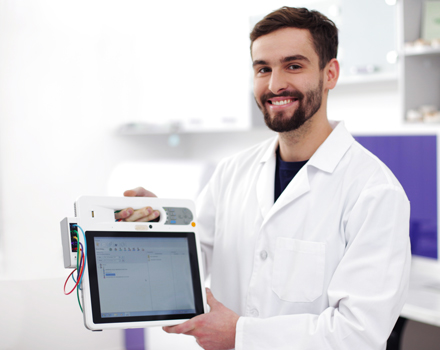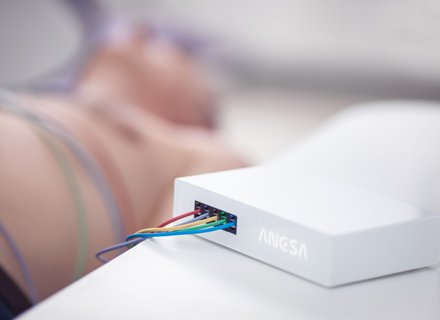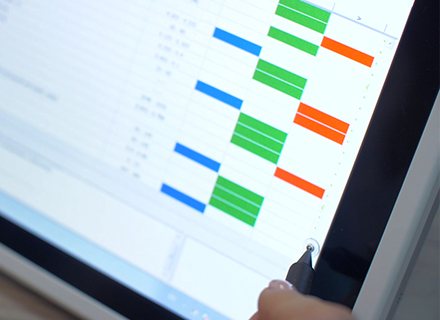Automatic non-invasive express screening analyzer ANESA determines 136 health parameters, that allows estimating the state of organs and the body systems, identifying the signs of pathologies and health threats. All within 6-12 minutes.
Order
ANESA allows medical professionals to easily monitor the health parameters of their patients on a regular basis. The device runs on deep learning algorithms, which allows identifying the signs of pathologies and health threats. Combination of user-friendly interface and convenient size of ANSEA adds value to the daily routine work of a medical professional, as it makes possible to carry out multifunctional screening of patients rather quickly. Perfect for health institutions, hospitals and clinics, sport/fitness and wellness centres, private practice of physicians.

Check-up of the functional state of a body at a given time.

A total of 136 hemodynamic, biochemical and immunological parameters

Ability to analyze and evaluate changes in health indicators over time.

Includes physical and emotional health of a patient

Deep learning algorithms identify risks and signs of pathologies of the cardiovascular system, GIT, urogenital system, etc.

Personal records in DB and detailed reporting available for every patient.

Secure data storage and simple exporting process.
The “User’s Manual” contains information about the intended use, principle of operation, capabilities of the analyzer and software USPIH. Technical and operational characteristics, product life-time and warranties are indicated. Maintenance, transportation, storage and disposal requirements for the analyzer are included in the UM, too. The process of measurement is described, namely: preparing the analyzer for work, setting up software USPIH and working with it.
The “User’s Manual” contains information about the intended use, principle of operation, capabilities of the analyzer and software USPIH. Technical and operational characteristics, product life-time and warranties are indicated. Maintenance, transportation, storage and disposal requirements for the analyzer are included in the UM, too. The process of measurement is described, namely: preparing the analyzer for work, setting up software USPIH and working with it.
The catalogue contains marketing related information. Key advantages of the device, segments and applications, uniqueness, user feedback. QR codes found within the catalogue will provide additional information.
Comparison of the Automatic Non-invasive Express Screening Analyser (ANESA)® for Clinical Analytical Parameters
Erythrocytes RBC. x10¹²/l, Hemoglobin HGB. g/l, Hematocrit.HCT %, Thrombocytes. x10⁹/l, Leukocytes WBC. x10⁹/l, Lymphocytes.LYMPH %, Monocytes.MONO %, Glucose. mmol/l, Cholesterol total. mmol/l, Low-density lipoproteins (LDL). mmol/l, High-density lipoproteins (HDL). mmol/l, Triglycerides (TG). mmol/l, ALT. U/l, AST. U/l, Bilirubin
Hemoglobin HGB. g/l, Erythrocytes RBC. x10¹²/l, Leukocytes WBC. x10⁹/l, Mean cell haemoglobin (MCH). Pg, Mean cell volume (MCV). Fl, Mean cell haemoglobin concentration (MCHC). g/l, CPB (Color index of blood), Lymphocytes.LYMPH %, Segmented neutrofiles.NEUT %, Eosinophils. %, Monocytes.MONO %, Stab neutrofiles.NEUT %, Erythrocyte sedimentation rate ESR. mm/h
Beginning of clotting (method of Lee-White). min, End of clotting (method of Lee-White). min, Thrombocytes. x10⁹/l, Fibrinogen. g/l, Prothrombin index (PI). %, Hematocrit.HCT %
Calcium (Ca). mmol/l, Magnesium (Mg). mmol/l, Potassium (K). mmol/l, Sodium (Na). mmol/l
pH of gastric juice, SH, Basal pressure of Oddi’s sphincter mm Hg
Lactic acid. mmol/l, Glucose. mmol/l, Glycogen. mg%
Aspartate transaminase (AST). mmol/l, Alanine transaminase (ALT). mmol/l, AST. U/l, ALT. U/l, De Ritis coefficient (AST/ALT), Bilirubin, Total. μmol/l, Bilirubin, Direct. μmol/l, Bilirubin, Indirect. μmol/l
Protein, Total. g/l, Creatinine. μmol/l, Dopamine β-hydroxylase (DBH). nm/ml/min, Urea. mmol/l
Triglycerides (TG). mmol/l, Low-density lipoproteins (LDL). mmol/l, Very low-density lipoproteins (VLDL). mmol/l, High-density lipoproteins (HDL). mmol/l, Cholesterol total. mmol/l, β- lipoprotein. mmol/l, β- lipoprotein. g/l
Cellular water. %, Total water. %, Extracellular water. %
Testosterone. μmol/24hours, Estrogen, Total . nmol/24hours, Thyroxine (T4),Total. nmol/l
Amylase (W.Т.Caraway). g/l*h, Acetylcholine. μg/ml, Acetylcholinesterase of erythrocytes. μmol/l, Tyrosine. mg*%, Creatine kinase MM (CK-MM). μmol/min/kg, Creatine kinase MB (CK-MB). μmol/min/kg
Comprehensive cell mitosis regulation factor
Myocardial blood flow. %, Muscular blood flow. %, Cerebral blood flow. %, Vena porte blood flow. %, Nephritic blood flow. %, Skin blood flow. %, Blood flow of other organs. %
Cerebral blood flow on 100g of tissue. ml/100g, Blood flow per 1gr of thyroid gland. ml/g, Blood flow per 1gr of cerebral tissue. ml/g, Cerebral spinal fluid pressure (CSF). mm H₂O, Width of the third ventricle of cerebrum. mm
Pulmonary vascular resistance (PVR). dyn/cm5*sec, Central venous pressure. mm H₂O, Time of pulmonary circulation. S, Time of systemic circulation. s, Energy Expenditure. kkal/kg/min, Oxygenation velocity of RBC. ml/min, Surface of gaseous exchange of RBC. m², Deficit of circulatory blood. ml/kg, Vital capacity of lungs (VC). cm³, Minute ventilation (VE) l/min, Functional residual capacity (FRC) cm³, Peak expiratory flow (PEF). l/min, Test Tiffeneau. %, Working rate of oxygen consumption. %, Time of single load. min, Respiratory exchange ratio (RER).
pH of blood., Volume of circulatory blood. ml/kg, Cardiac output (CO). l/min, Transportation of oxygen(O₂). ml/min, Quantity of assimilated oxygen on 100 gr. of cerebral tissue. Ml, Oxygen saturation in arterial blood (SaO₂). %, Oxygen consumption per kg of body weight. ml/min/kg, O₂ consumption.(VO₂) ml/min, Myocardial oxygen consumption. ml/min Oxygen extraction index.
CO₂ elimination. ml/min, (CO₂) in arterial blood. %, (CO₂) venous blood. %, Rate of CO₂ production. ml/min
Vascular Permeability Index., Stroke volume (SV). ml, Interval PQ. sec, Interval QT. sec, Interval QRS. sec, Left ventricular Stroke Work Index. %, Systolic arterial pressure. mm Hg, Diastolic arterial pressure. mm Hg, Plasma density. g/l, Cardiac work. Joule/p>
eGFR [MDRD]. ml/min/1.73m², Estimated creatinine clearance, rate(eCCr)[Cockroft and Gault]. ml/min, Cystatin C (CysC). mg/l, BUN. mg/dl, Transferrin. mg/dl, Urine specific gravity. g/cm³, Chloride. mmol/l, Ceruloplasmin (CP). g/l, Alkaline phosphatase (ALP). μkat/L, Intracranial pressure (Test)(ICP). mmHg

Innovative and painless diagnostic procedure without any risks of infection, irritation or irradiation. Safe for both, patient and the doctor. Removes risk of the following infections: hepatitis C, HIV, etc.
AI and deep learning algorithms evaluate external and internal factors, remove human error and calibrate results for each individual. Multiple clinical test and external evaluations guarantee highest level of parameter reliability. Large amount of measurements contribute towards identification of health pathologies and risks at their early stages.


Non-invasive technologies and considered eco-friendly, as no plastic containers or bags are needed for data collection. From cost perspective, ANESA does not require any additional chemical reagents, special substances or consumables. Free and automatic updates ensure the device is always up to date with latest software updates.